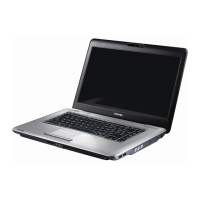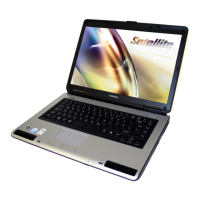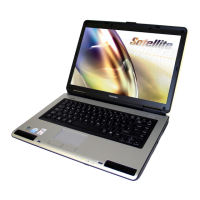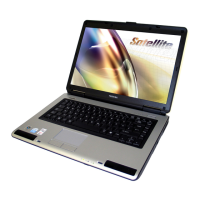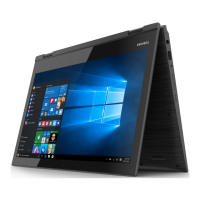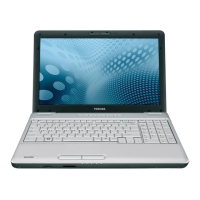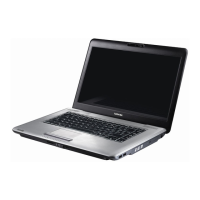
Do you have a question about the Toshiba Satellite Pro L450 Series and is the answer not in the manual?
| Battery | 6-cell Lithium-ion |
|---|---|
| LAN | 10/100 Ethernet |
| Processor | Intel Core 2 Duo |
| RAM | 2GB DDR2 |
| Storage | 250GB HDD |
| Display | 15.6-inch HD (1366x768) TruBrite |
| Graphics | Intel GMA 4500M |
| Operating System | Windows Vista |
| Chipset | Intel GM45 Express |
| Optical Drive | DVD SuperMulti |
| Wireless | 802.11 b/g |
| Ports | 3 x USB 2.0, VGA, Microphone input, Headphone output, RJ-45 |
Overview of the manual's chapters, appendices, glossary, and index.
Explains document formatting, abbreviations, icons, and key notations used.
Safety guidelines for computer use, environment, and health.
Lists included hardware and provides a general overview of the computer.
Details pre-installed operating system and utility software.
Describes key hardware components like processor, memory, and ports.
Covers sound system, web camera, LAN, and wireless LAN functions.
Information on adding memory, battery packs, and external peripherals.
Identifies and describes external ports and slots on the computer.
Details locations of battery, memory slots, and hard disk drive on the computer's underside.
Describes webcam, speakers, touch pad, and power button when display is open.
Explains LED indicators for system status and keyboard functions.
Details optical drive capabilities and AC adaptor specifications.
Guides on connecting the AC adaptor for power and charging.
Instructions for turning the computer on, off, hibernating, and sleeping.
Steps for using system recovery options and creating recovery media.
Explains how to use the touch pad and optical disc drives.
Guides on writing to CDs/DVDs and proper media handling.
Details sound system adjustments and web camera usage.
Instructions for connecting and using modem, LAN, and wireless network.
Guidelines for cleaning, moving, and heat dispersal of the computer.
Explains typewriter keys, function keys, and FN key combinations.
Details specific hot keys for system control and special Windows keys.
Instructions for enabling and using the numeric keypad overlay.
Explains system power indicators and battery charge status.
Covers battery types, care, charging, monitoring, and replacement.
Guides on setting and managing user and supervisor passwords.
Details system power modes like Sleep, Hibernation, and auto-off settings.
Introduces the HW Setup utility for configuring system settings.
Explains how to configure BIOS settings and display options.
Covers setting user passwords and defining boot device priority.
Details settings for Keyboard, USB, and LAN.
Information on installing memory modules and using media card slots.
Details battery packs, AC adaptors, and battery chargers.
Guides on connecting external monitors, HDMI, and USB floppy drives.
Instructions for attaching a security cable to the computer.
Steps for identifying and solving computer problems effectively.
Addresses problems with startup, power, and basic system components.
Solutions for issues related to battery, keyboard, display, drives, and connectivity.
Information on contacting TOSHIBA for technical assistance.
Notes on factors affecting CPU performance and 64-bit computing.
Disclaimers related to memory, HDD capacity, LCD, and GPU performance.
Disclaimers for Wireless LAN, external HDD, icons, copy protection, and images.
Lists operating and non-operating environmental conditions and power specifications.
Provides specifications for the internal modem, including protocols and speeds.
Explains how the display controller interprets commands and manages video modes.
Details the V.90/V.92 modem technology and data transmission speeds.
Lists form factor, compatibility, protocol, and data rates for wireless LAN cards.
Describes factors affecting wireless signal range and supported frequency bands.
Outlines length, wire size, current, and voltage ratings for power cords.
Lists certification bodies and shows plug shapes for various regions.
Defines terms and abbreviations used throughout the manual.
